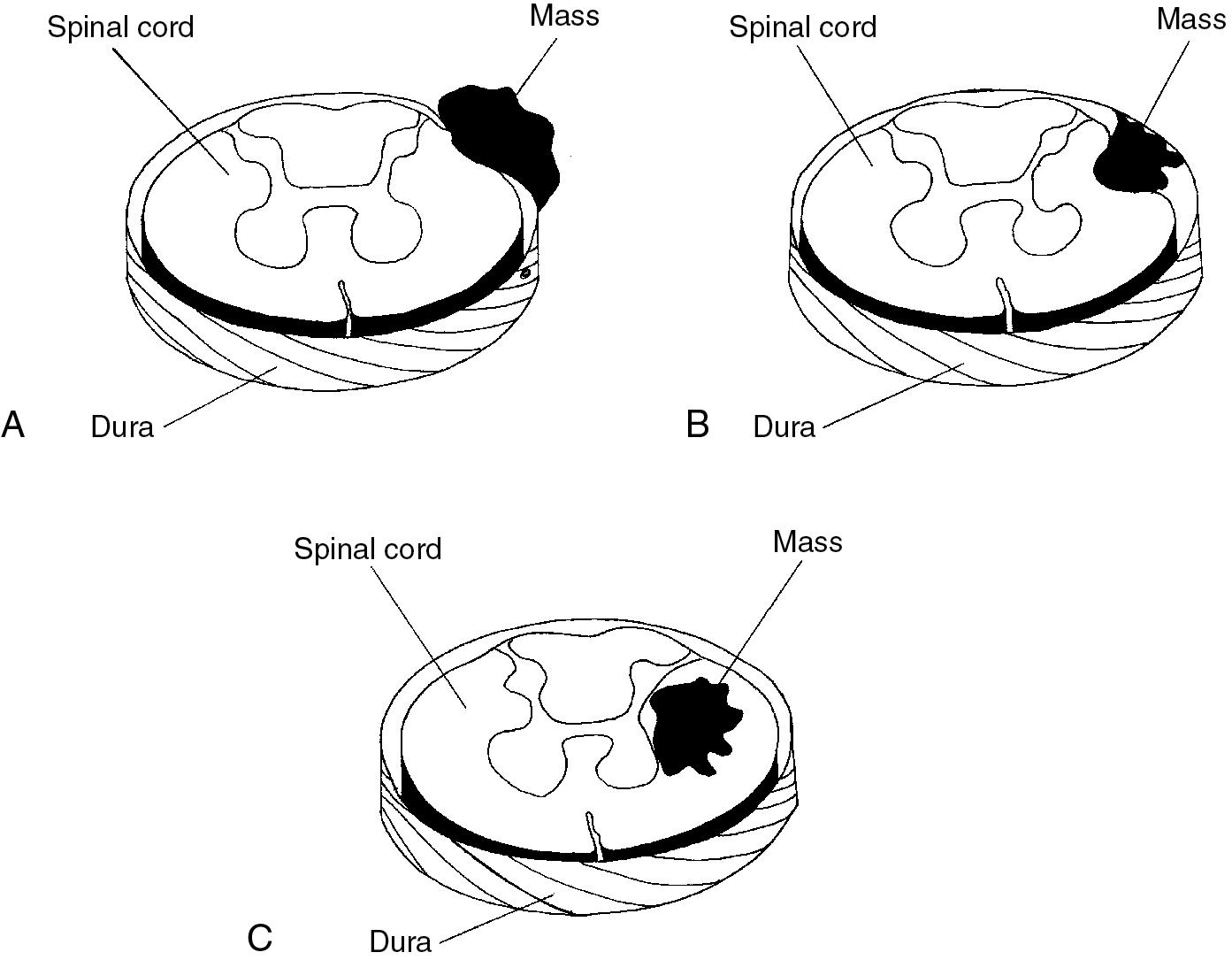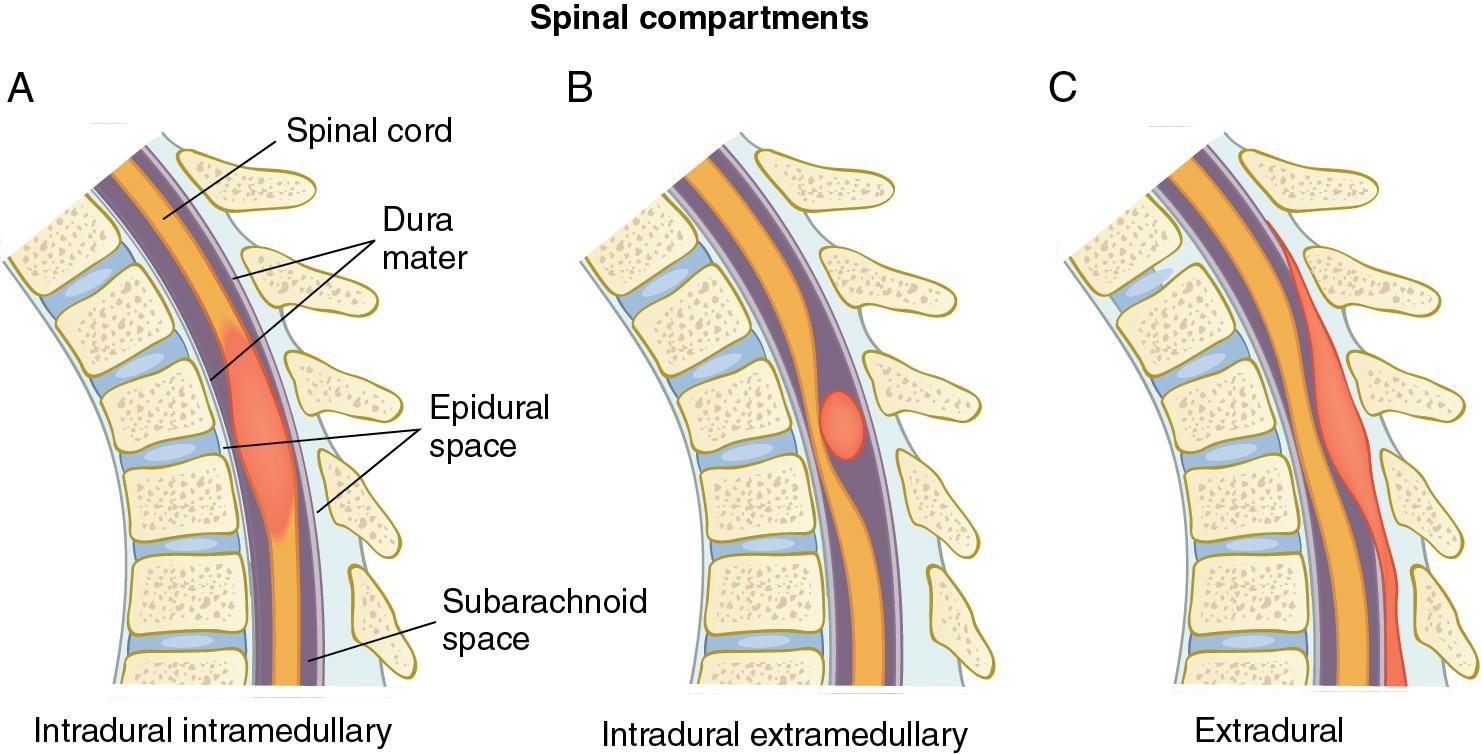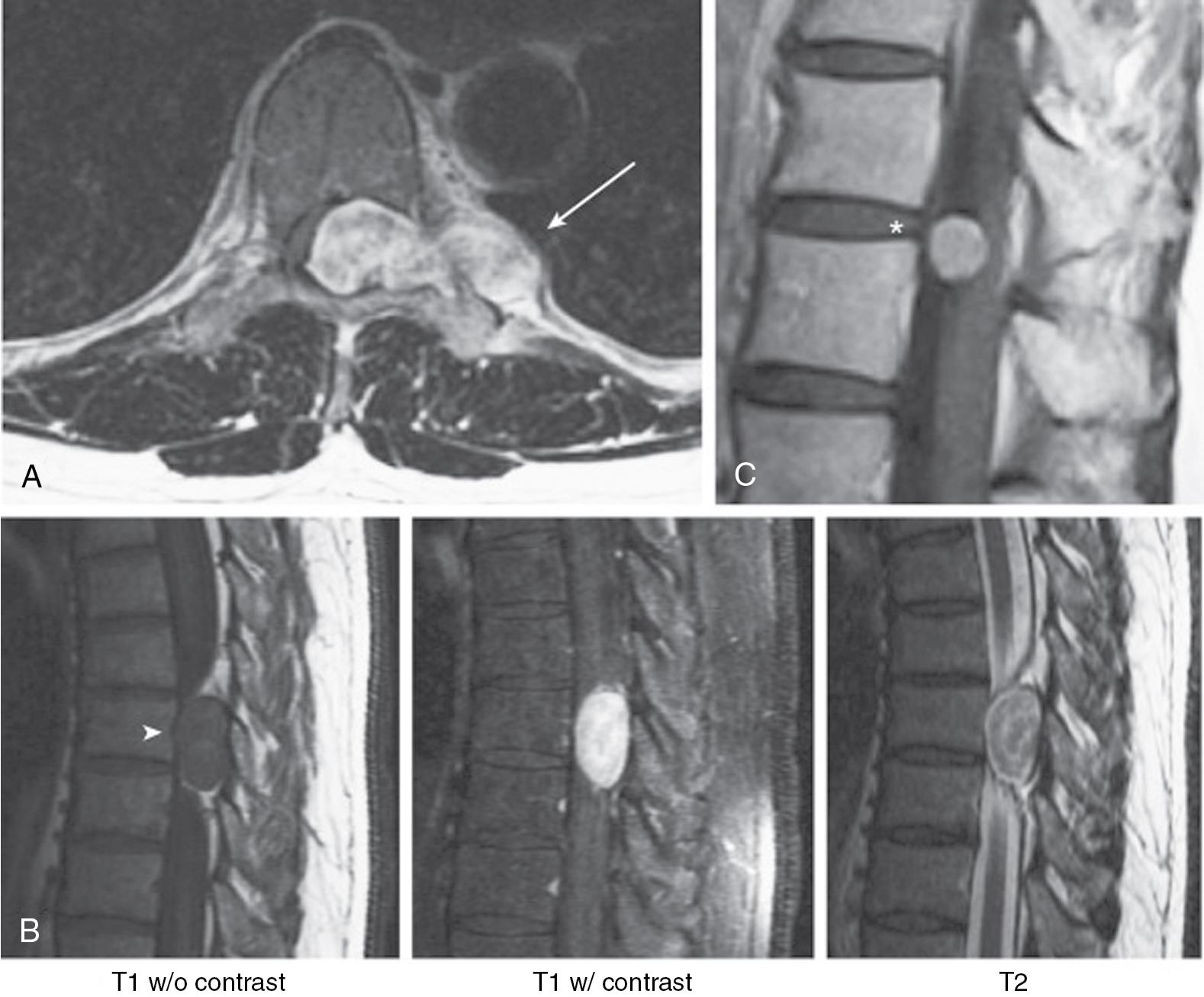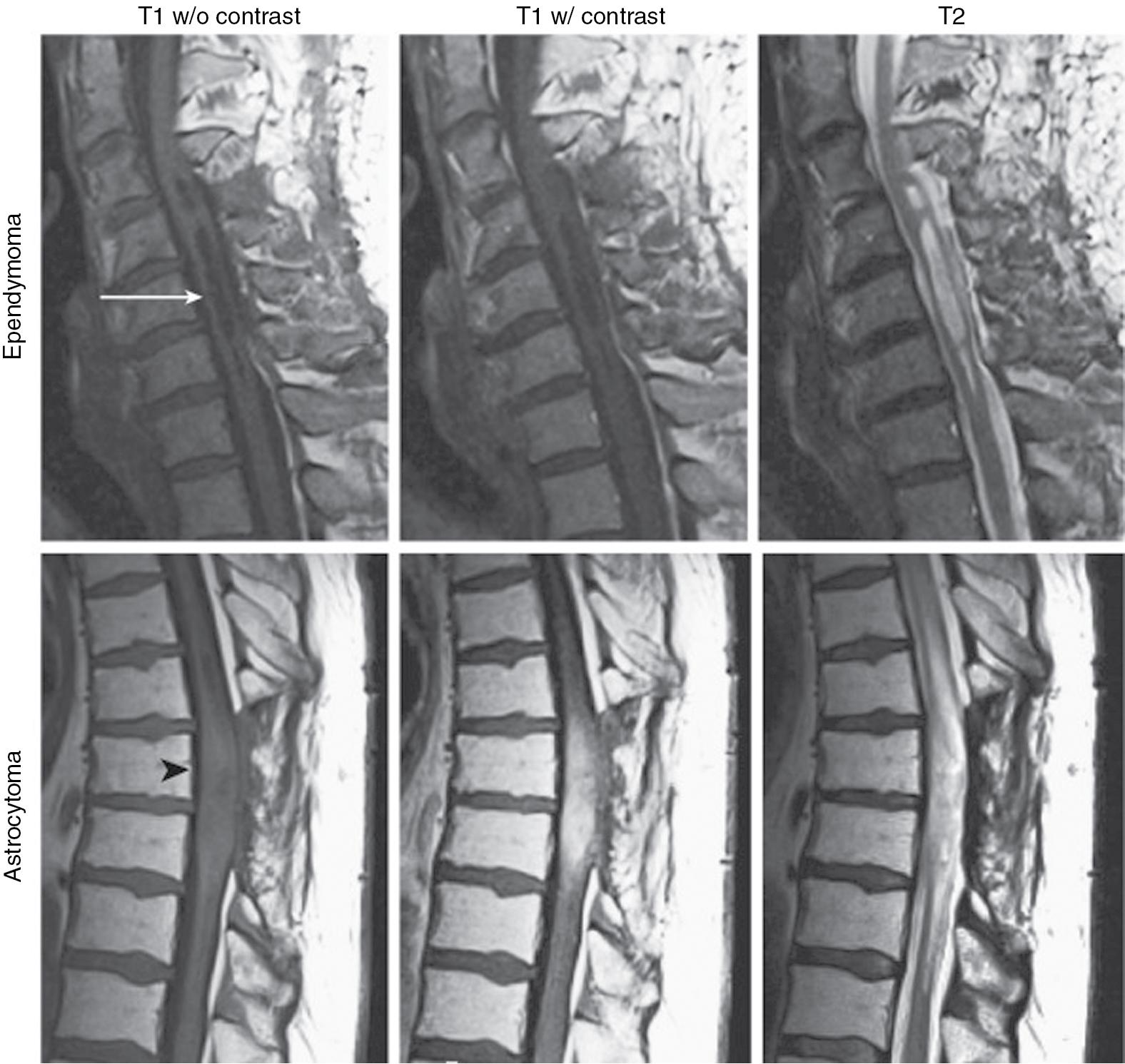Physical Address
304 North Cardinal St.
Dorchester Center, MA 02124
Spine tumors are localized according to the anatomic compartment in which they occur: extradural , intradural-extramedullary , or intramedullary ( Figs. 61.1 and 61.2 ). Certain tumors may invade multiple anatomic planes.
Extradural tumors may be primary spinal tumors (benign or malignant) or secondary tumors (due to metastatic disease).
Intradural-extramedullary tumors arise within the dura but outside the spinal cord. These tumors displace the spinal cord toward the contralateral side of the thecal sac. The most common tumors arise from the sheath cells covering the spinal nerve root (schwannoma, neurofibroma) or from the arachnoid cap cells in the dura (meningioma). If the tumor arises as the nerve root leaves the dural sac, it may possess both an intradural and extradural component (dumbbell-shaped tumor).
Intramedullary tumors originate from the parenchyma of the spinal cord. The characteristic pattern on magnetic resonance imaging (MRI) is widening of the spinal cord and narrowing of the cerebrospinal fluid (CSF) space over several vertebral levels. These tumors are located within the spinal cord and typically enhance with administration of gadolinium. Syringomyelia and perilesional cysts are frequently associated with these lesions.


The extradural anatomic compartment is the most common location for a spinal tumor. Approximately 60% of all spine tumors are extradural and 40% are intradural. Among intradural tumors, approximately 75% are extramedullary and 25% are intramedullary. Intradural-extramedullary tumors are more common in adults, while intramedullary tumors are more common in children. Intradural tumors are equally common in males and females, with the exception of meningiomas, which occur more frequently in females.
Extradural tumors arise as primary tumors originating from the vertebra and adjacent soft tissues or develop secondary to metastatic disease. The most common extradural spinal tumor is a metastatic tumor. Primary bone tumors are uncommon. Myeloma is the most common primary spine neoplasm. Some common tumor types to consider in the differential diagnosis of an extradural spinal tumor are listed in Table 61.1 .
| Primary Spine Tumors | METASTATIC SPINE TUMORS | |
|---|---|---|
| Benign | Malignant | |
| Hemangioma | Myeloma | Breast |
| Osteoid osteoma | Lymphoma | Prostate |
| Osteoblastoma | Chordoma | Lung |
| Osteochondroma | Ewing sarcoma | Thyroid |
| Giant cell tumor | Chondrosarcoma | Renal |
| Aneurysmal bone cyst | Osteosarcoma | Melanoma |
| Langerhans cell histiocytosis | Gastrointestinal | |
Eighty percent of the tumors in the intradural-extramedullary space are schwannomas, neurofibromas, or meningiomas ( Fig. 61.3 ). Tumors of the intradural-extramedullary space account for approximately 60% of all intradural spinal tumors in adults but occur less commonly in children. Nerve sheath tumors (schwannomas, neurofibromas) arise from sheath cells covering the spinal nerve roots, while meningiomas arise from arachnoid cap cells, dural fibroblasts, or pial cells localized at the spinal cord surface. Approximately 5% of intradural-extramedullary tumors have both an intradural and extradural component (dumbbell tumors).

Schwannomas are the most common type of nerve sheath tumor. These benign encapsulated nerve sheath tumors are comprised of proliferating Schwann cells and usually occur as a solitary lesion. The presence of multiple spinal schwannomas warrants evaluation for schwannomatosis, a rare genetic disorder that is recognized most often in patients over 30 years of age.
Neurofibromas are benign, unencapsulated nerve sheath tumors comprised of proliferating Schwann cells mixed with fibroblasts and occur less commonly than schwannomas. Over half of these tumors occur in patients with neurofibromatosis type 1 (NF1) and occasionally may undergo malignant degeneration to malignant peripheral nerve sheath tumors (MPNSTs).
Meningiomas occur most frequently in females between 40 and 80 years of age, and typically present as isolated lesions, except in patients with neurofibromatosis type 2 (NF2). These tumors are slow-growing, encapsulated tumors that are most commonly located in the thoracic region along the dorsolateral aspect of the spinal cord, but may occasionally occur in the cervical region or along the anterior aspect of the spinal cord.
Other tumor types may occur in the intradural-extramedullary space but are less common ( Table 61.2 ).
| Schwannoma | Ependymoma |
| Neurofibroma | Paraganglioma |
| Meningioma | Epidermoid and dermoid cysts |
| Hemangiopericytoma | Subarachnoid seeding of metastatic disease |
| Lipoma |
The most common types of intramedullary tumors are ependymomas, astrocytomas, and hemangioblastomas ( Table 61.3 , Fig. 61.4 ). In adults ependymomas are the most common tumor type, while in children astrocytomas are most common.
| Ependymoma | Neuroblastoma |
| Astrocytoma | Gliomas (malignant oligodendroglioma, ganglioglioma) |
| Hemangioblastoma | Epidermoid and dermoid cysts |
| Lipoma | Spinal cord metastasis |

Ependymomas arise from the cuboidal ependymal cells that surround the ventricular system and central canal of the spinal cord. As the tumor enlarges in the central canal, the flow of CSF is obstructed and cystic cavities frequently develop above and below the lesion.
Astrocytomas result from malignant transformation of astrocyte cells, which are glial cells that provide nutritional support to neurons and axons. The majority of tumors are low grade, but more aggressive and infiltrating types such as glioblastoma multiforme (GBM) may occur and are associated with a very poor prognosis.
Hemangioblastomas are the most common intramedullary spinal cord tumor of nonglial origin. These are highly vascular lesions that often have a very large syrinx compared with the size of the tumor. Hemangioblastomas of the spine typically occur as solitary lesions, but may also present as multiple lesions in patients with von Hippel-Lindau (VHL) disease, an autosomal dominant disorder associated with the development of tumors in different organs.
The most common intradural tumors presenting in the region of the conus medullaris or cauda equina include myxopapillary ependymoma, schwannoma, meningioma, and lipoma. Metastatic tumors may also occur but are less common.
In general, most intradural tumors present with an insidious onset of symptoms, although occasionally, intradural tumors may present with acute neurologic deterioration secondary to intratumoral or extramedullary hemorrhage. Because of the slow-growing nature of many intradural spinal tumors, symptoms tend to precede diagnosis for periods ranging from months to years. Pain is often the earliest symptom and is typically reported as occurring at night. The clinical signs and symptoms associated with an intradural spinal tumor are related to the level of the lesion along the spinal column (cervical, thoracic, lumbar, sacral), tumor location , and the rate of tumor growth . Motor dysfunction, sensory dysfunction, reflex abnormalities, long tract signs, and autonomic dysfunction (bowel, bladder, and/or sexual dysfunction) may occur. Cervical tumors may present with occipitocervical pain, upper extremity pain, and myelopathy with sensory changes or hand weakness or clumsiness and/or balance/gait dysfunction. Thoracic tumors may present with thoracic radicular pain, sensory changes involving the trunk and/or lower extremities, and myelopathy involving the lower extremities. Tumors involving the conus medullaris may present with a mixture of upper and lower motor neuron (LMN) findings involving the lower extremities and often are accompanied by bowel and/or bladder dysfunction. Tumors involving the cauda equina often present with radicular symptoms involving the lower extremities. Notably, back and leg pain are often worse with lying down and relieved with erect posture. An LMN syndrome may develop and include flaccid paraparesis, loss of reflexes, segmental sensory loss, and sphincter dysfunction, although this is an uncommon acute presentation due to the typical slow-growing nature of cauda equina tumors. MRI with and without gadolinium enhancement is the imaging modality of choice for diagnosis of intradural tumors. Consideration should be given to performing a screening MRI of the entire neural axis as subarachnoid seeding of tumor is possible, particularly with ependymomas. Histologic evaluation of tumor tissue after biopsy or surgical resection is used to establish a definitive diagnosis.
Extramedullary tumors frequently cause unilateral symptoms due to their eccentric location (i.e., unilateral radicular pain, unilateral spastic weakness, Brown-Séquard syndrome). For tumors of nerve sheath origin such as schwannomas and neurofibromas, radicular pain and sensory changes are the most common initial presentation, as these tumors typically develop in the dorsal sensory roots. Myelopathic signs develop later as the tumor increases in size and causes spinal cord compression. The initial presentation of spinal meningiomas is variable and may include pain, unilateral or bilateral numbness, and/or weakness, and myelopathy.
Intramedullary tumors most commonly present with pain. Pain is often described as burning, poorly localized, and involving large areas of the body. Tumors may disrupt the spinothalamic tracts but spare the dorsal columns, which are relatively resistant to tumor infiltration and cause a dissociated sensory loss (loss of pain and temperature sensation without loss of position and vibration sensation). Additional presentations include motor dysfunction, reflex abnormalities, long tract signs, gait abnormalities, or autonomic dysfunction (bowel, bladder, and/or sexual dysfunction). Children may present with clumsiness, frequent falls, progressive scoliosis, or torticollis.
Intradural-extramedullary spinal cord tumors tend to be histopathologically benign and can be successfully resected in the majority of patients, most commonly through a posterior surgical approach. Tumors in an anterior location and dumbbell-shaped tumors are more challenging to treat surgically as these tumors generally require more extensive surgical exposures to facilitate safe access for tumor resection. Radiotherapy or chemotherapy is generally reserved for tumors with malignant histologic characteristics and for recurrent tumors.
Intramedullary spinal cord tumors are typically treated with open surgical resection. Advances that have transformed the surgical treatment of these lesions include MRI, microscopic surgical techniques, improved surgical instrumentation, intraoperative ultrasound, the ultrasonic aspirator, and intraoperative neurophysiologic monitoring. A posterior midline surgical approach is most commonly utilized. Following laminectomy, a midline myelotomy is made in the posterior aspect of the spinal cord to minimize injury to the posterior columns of the cord. The midline is located by identifying the midpoint between the dorsal root entry zones, identifying where blood vessels enter into the spinal cord or by dorsal column mapping using neurophysiologic monitoring. However, this can be challenging in many cases due to distortion of normal anatomy by the tumor. The aggressiveness of surgical resection is dependent on the histologic diagnosis based on intraoperative frozen section and the ability to locate and maintain a surgical plane. Well-circumscribed tumors such as ependymoma and hemangioblastoma are typically amenable to gross total resection. Well-differentiated astrocytomas are amenable to resection, but infiltrative and high-grade types are impossible to completely resect and their treatment remains controversial. Radiotherapy and chemotherapy are reserved for high-grade malignant lesions and for lesions that are not surgically resectable.
Due to the midline myelotomy approach to intramedullary tumors, nearly all patients have postoperative dorsal column sensory abnormalities, particularly with proprioception, that may take at least several months to resolve or improve. Many patients also have additional significant neurologic deficits in the immediate postoperative period due to spinal cord manipulation that will often improve over time, unless there has been permanent damage to the motor tracts. Some surgeons have found that intraoperative neuromonitoring with motor evoked potentials and epidural D-wave monitoring may be predictive of postoperative neurologic function.
A syrinx is a cystic dilatation or cavitation that develops within the substance of the spinal cord. Hydromyelia refers to a dilatation of the central canal with an ependymal-cell lining. Syringomyelia is an eccentric cavitation that is not lined by ependyma. Although hydromyelia and syringomyelia are described as distinct entities, it is not possible to separate these entities in practice and these lesions are most appropriately referred to as syringohydromyelia . A syrinx extending into the brainstem is called syringobulbia .
Syringohydromyelia may be idiopathic or arise as the result of spinal cord trauma, tumors, spinal cord infarction, postradiotherapy, hemorrhage, or developmental anomalies (e.g., Chiari malformation, basilar invagination), or spinal cord tethering.
Dissociated sensory loss: A centrally located syrinx disrupts the decussating spinothalamic tracts (loss of pain and temperature sensation), while dorsal column function remains intact (position and vibration sensation is preserved). When this pattern of sensory loss involves the shoulders and upper trunk it is described as a “cape-like” pattern.
Dysesthetic pain: Severe pain may develop and most commonly involves the trunk and upper extremities.
LMN lesions: Involvement of the anterior horn cells leads to atrophy, weakness, and absent reflexes below the level of the lesion. Lesions that involve the cervical cord lead to muscle atrophy, which begins distally in the hands and progresses to involve more proximal musculature.
Bulbar lesions: Syringobulbia can manifest as tongue fasciculations, hoarseness, facial anesthesia, and dysphagia.
Autonomic system involvement: Horner syndrome, impaired bowel or bladder function.
Musculoskeletal manifestations: Scoliosis, Charcot arthropathy (classically the shoulder joint is involved), basilar invagination, Klippel-Feil anomaly.
Become a Clinical Tree membership for Full access and enjoy Unlimited articles
If you are a member. Log in here